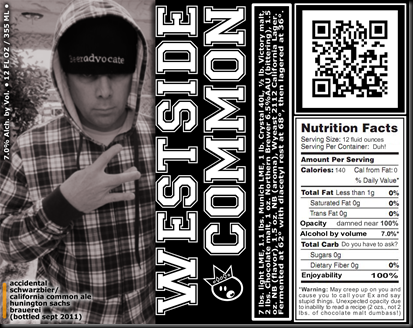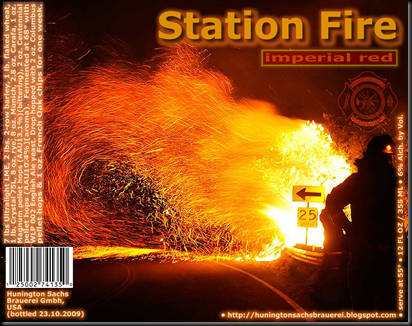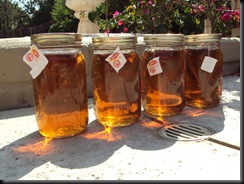 This was supposed to be a classic Belgian Wit with a spicy undertone and easy drinkability, but plussed-up in the style of Avery's White Rascal. I had consulted Jamil Zainasheff's Brewing Classic Styles podcast, which is usually an authorative source, but this one was hosted by a fill-in who suggested that the brewer use a softball-sized addition of citrus zest, and said that "you can never get too much citrus in this beer." Well, I should've known. By the time this one fermented out, the orange flavor was overwhelming, so I decided to make this a bigger beer to try to balance it out by adding more sugar in the manner of Abbey Triples. That helped, but the acid balance was still off, so I dosed it with lactic acid to taste. It wasn't the phenolic Avery I aimed for, but it did have a nice big citrus quench, reminiscent of my favorite orange soda, Orange Crush.
This was supposed to be a classic Belgian Wit with a spicy undertone and easy drinkability, but plussed-up in the style of Avery's White Rascal. I had consulted Jamil Zainasheff's Brewing Classic Styles podcast, which is usually an authorative source, but this one was hosted by a fill-in who suggested that the brewer use a softball-sized addition of citrus zest, and said that "you can never get too much citrus in this beer." Well, I should've known. By the time this one fermented out, the orange flavor was overwhelming, so I decided to make this a bigger beer to try to balance it out by adding more sugar in the manner of Abbey Triples. That helped, but the acid balance was still off, so I dosed it with lactic acid to taste. It wasn't the phenolic Avery I aimed for, but it did have a nice big citrus quench, reminiscent of my favorite orange soda, Orange Crush.
-6 lbs. wheat malt extract
-1 lb. oat flakes (for smooth mouth feel)
-2 lbs. table sugar (1/2 in the boil, and 1/2 during secondary)
-2 oz. Crystal pellet hops (bittering)
-1/2 oz. fresh Chamomile Tea from Market Spice
-2 oz. crushed Indian Coriander Seed (1/2 in last 10 min. of boil and 1/2 dry-hopped in the secondary)
-a whopping softball-sized ball of citrus zest from tangerines, navel & blood oranges, grapefruit & lemon, plus orange marmalade (to mimic the Curacao peel)
-fermented with White Labs WLP410 at 64 degrees
-carbonated with 5 oz. dextrose plus an extra 3 oz. sucrose (to obtain that "Belgian" fizz)
The label is a variation on both the new and old Orange Crush Soda cans. I added Ethiopian Emperor Haille Salassie's image, not because it has anything to do with Belgian beers, but because the colors matched the Crush signature colors so perfectly, and Selassie's larger-than-life reign was so over-the-top extreme that it seemed to fit with this extreme, citrusy, huge Belgian wit.
Brewed September 2008 with additions in October, November and December. My first "Extreme Beer".
January 2009 Update. The carbonation and bottle conditioning made a huge difference. It's shocking, but the beer is much closer to the Avery than I expected based upon how it tasted in the Carboy. When my Father-In-Law brewed his Celis White clone he initially hated it, waited a few months, then loved it. What is it about Wits that bottle conditioning seems to make all the difference? I'm even getting a nice Belgian funk as well. Wow, I love it. Caution: Truly "Imperial" on the alcohol side.













